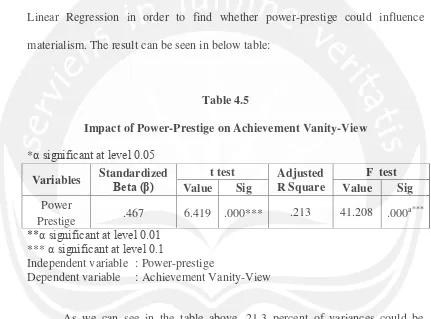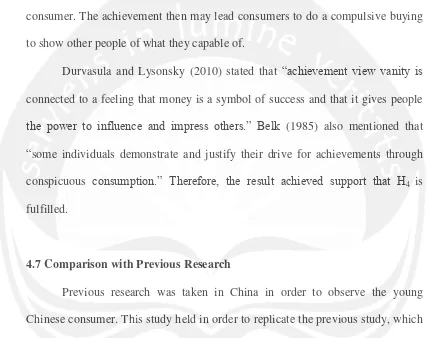CHAPTER 4 DATA ANALYSIS
4.1 Introduction
This chapter explains about the analysis of the collected data which gathered by distributing questionnaires to the respondents who are ranging from 15 to 24 years old with the most respondent are university students in DIY (Daerah Istimewa Yogyakarta).
This study used Microsoft EXCEL 2007 SPSS version 16.0 in order to calculate and processing the raw data that already collected. Several analyses will be done, where validity and reliability analysis will be used to test the validity and reliability of the data and continued by regression analysis to reveal the relative importance of the determinants.
4.2 Response Rate
the questionnaires that were distributed to the respondents that took place in boarding houses. The reasons of inability to obtain the 36 questionnaires are because the respondents are not in town due to holidays, and most of the questionnaires were lost by the respondents due to the same reasons.
The obtained questionnaires from 150 respondents are completed and ready to be analyzed with a percentage of response rates that calculated below:
Response Rates = 150/190 x 100% = 78.9%
The result shows that the response rate is considered as moderated high. Therefore, the level of data bias of this sampling can be assumed to be low and can be used for the study.
4.3 Validity and Reliability Analysis 4.3.1 Validity Analysis
Validity is a test of how well an instrument that is developed measures the particular concept it is intended to measure and concerned with measuring the right concept and reliability with stability and consistency of the measurement.
Table 4.1 Validity Analysis
Item Corrected Item-Total Correlation R-TABLE Conclusion
The table of all variables above shows that all of the variables in all dimensions are higher than 0.1603 of the r-table which means that all of the questions in this research are valid.
4.3.2 Reliability Analysis
Reliability analysis is conducted to check whether the questionnaire of research is reliable or not. The table below shows the result of the reliability analysis.
Table 4.2 Reliability analysis
A well acceptable value of Cronbach’s alpha is recommended to be 0.6 as
suggested by Hair et al. and Flynn et al. (1994, as cited in Bassioni et.al, 2008).
Thus, results in Table 4.2 shown that the reliability analyses for all of the variables have exceeded 0.70 are assumed to be reliable. This results shows that the questionnaire in this research is reliable.
4.4 Demographic Analysis
In order to know the profile of the correspondents, demographic analysis was conducted. The results will be shown as follow.
Table 4.3
Respondent Profiles
Aspect Description Frequency Percentage (%)
person, which is 50% for total population of each gender. This number has been reached accidentally while the questionnaire itself was distributed randomly to male and female.
4.4.2 Age
The questionnaires were intended to collect the data of people whose age are in range from 15 to 24 years old. The mean of the respondents is 21.03 years old. The table below shows that most of the correspondents are in age of 21 years old with 30 percent (45 respondents) of the total respondent. It is followed by respondents in age of 22 years old with 28 percent (42 respondents), 21 years old with 12 percent (18 respondents), age of 18, 19, 23 and 24 with 6.7 percent (10 respondents for each category) and finally 17 years old with 3.3 percent of total (5 respondents) as the least age category in age.
Figure 4.1 Age
4.4.3 Income
The data shown below show that the respondents’ income mostly
Figure 4.2 Income
lived in boarding house to live with only Rp 500,000 or less monthly. Another population with income in range between Rp 1,500,001 – Rp 3,000,000 and income more than Rp 3,000,000 still assumed as university students from outside province who are more well-fortuned or already have a job.
4.4.4 Race
According to the data collected, the most respondents are Tionghoa race (Chinese) with 52.7 percent (79 person), which then followed Javanese in the second place with 34 percent (34 person), and then Batak with 4.7 percent (7 person), Bali with 3.3 percent (5 person), Ambon with 0.7 (1 person), and the last are the respondents whose race is not mentioned in the questionnaire. They are Dayak with 1.3 percent (2 person), Flores with 1.3 percent (2 person), and Timor, India and Sunda for 0.7 percent each (1 person for each race).
Figure 4.3 Race
4.5Money Attitudes toward Materialism
Table 4.4
Multiple Regression Analysis for Money Attitudes toward Materialism
Variables Standardized Beta (β) t Test Adjusted R Square
Independent variable : Power-prestige, Distrust, Anxiety Dependent variable : Materialism
Based on ANOVA test, the F value = 53.045 appears to be significant where α < 0.1, which means that the model can proceed and will be able to interpret the calculation. The table 4.4, as is proved by the Adjusted R2 value, 51.2 percent variances of materialism could be explained by the variance of power-prestige, distrust, and anxiety, while the other 48.8 percent of the variances can be explained by other factors.
According to the result shown in the table 4.4, power-prestige with β = 0.384 and Sig. value = .000 and anxiety with β = 0.455 and Sig. value = .000 are be significant predictors of materialism. Distrust is the only variance predictor that does not have significant influence toward materialism.
activity. When consumers feel hesitate to spend their money, they purchase will tend to avoid compulsive buying.
Based on the result, anxiety with β = 0.455 is likely to be the most influence variance toward materialism, much more influencing than power-prestige with β = 0.384. The significant influences by those two variances are clearly shown by the materialist. Materialists tend to spend their money to purchase things which lead to compulsive buying in order to show off, and more likely, to avoid the opinion that they are not able to purchase something and being looked down by others. The more things they purchase, the more satisfied they are.
So, we can conclude that consumers who have a high tendency toward power-prestige and anxiety will clearly influence materialism. As mentioned by Durvasula and Lysonsky (2010), ―those who are materialistic are likely to see
money as the necessary ingredient they need to acquire material goods; not having money to achieve materialistic goals is likely to aggravate one’s anxiety about the
need for money.‖ According to this conclusion, then H1 and hypothesis H3 are
fulfilled.
A different result showed by Distrust, where the variable appears to be insignificant. The result means that distrust dimension has no influence toward materialism. Durvasula and Lysonsky (2010) mentioned that ―lack of a significant
relationship between distrust and materialism indicates that materialism was not involved in creating feelings of hesitancy, suspiciousness, and doubt regarding situation involving money and a lack of faith in one’s ability to make efficient
4.6Power-prestige toward Achievement Vanity-view
Power prestige dimension, as an element of money attitudes, has been seen as an independent factor that could influence the achievement vanity-view.
Consumers will tend to spend their money in order to impress other people by showing off what they could get by their money, which they think as the symbol of their successful achievement. In this study, the calculation done in Linear Regression in order to find whether power-prestige could influence materialism. The result can be seen in below table:
Table 4.5 variance can be explained by other factors. According to the ANOVA test result, F value resulting in 41.208 and appears to be significant with α < 0.1, which means that the model can be proceed and will be able to interpret the calculation.
According to the result shown in the table, it is mentioned that power-prestige with β = 0.467 and Sig. value = .000 appear to be a significant predictor
that could influence achievement vanity-view. Result in Table 4.5 above shows that β value of power-prestige shows positive relationship with achievement vanity-view. Power-prestige, as has been explained before, is one of the variance that can drive consumers to do a compulsive buying. The ability to purchase a lot of things can be an act that shows the result of what have been achieved by consumer. The achievement then may lead consumers to do a compulsive buying to show other people of what they capable of.
Durvasula and Lysonsky (2010) stated that ―achievement view vanity is connected to a feeling that money is a symbol of success and that it gives people the power to influence and impress others.‖ Belk (1985) also mentioned that ―some individuals demonstrate and justify their drive for achievements through conspicuous consumption.‖ Therefore, the result achieved support that H4 is fulfilled.
4.7Comparison with Previous Research
Table 4.6
Power-prestige towards Materialism Significant Significant Positive
Anxiety towards Materialism Significant Significant Positive
Distrust towards Materialism Insignificant Insignificant Negative
Power-prestige towards Achievement
Vanity-view
Significant Significant Positive
suggested by Hair et al. and Flynn et al. (1994, as cited in Bassioni et.al, 2008) to








